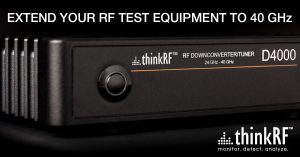ThinkRF Corp., the leader in software-defined spectrum analysis, today announced the launch of its new ThinkRF D4000 RF Downconverter/Tuner. The platform is the industry’s first 40 GHz downconverter/tuner that offers a frequency range of 24-40 GHz with up to 500 MHz of real-time bandwidth (RTBW), to capture mmWave 5G signals. Now, engineers can quickly and reliably analyze new 5G wireless signals by extending the range of their existing RF test equipment. Also, use of existing RF test equipment means minimal training requirements for RF Engineers. To leverage the performance, latency, and capacity that 5G promises, you need equipment that can properly analyze the higher frequencies and wider bandwidths of these new signals. This compact, plug-and-play ThinkRF downconverter/tuner allows you to easily upgrade your existing field, lab, and manufacturing test equipment, reducing time to market and cost significantly.

“The ability to measure new, high-frequency 5G signals is becoming a necessity,” said Dr. Jasvinder Obhi, VP, Product Management and Marketing, ThinkRF. “Unfortunately, many existing spectrum analyzers and test equipment are stuck with low-frequency ranges of the past, meaning they’re unable to measure the bands of the future. Our high-performance, 40 GHz downconverter/tuner is a huge leap forward for the industry and allows our customers to extend their existing equipment and analyze 5G signals in a cost-effective way.”
The ThinkRF D4000 RF Downconverter/Tuner offers 24-40 GHz frequency, 500 MHz real-time bandwidth, and 100 kHz tuning resolution, which is ideal for applications such as interference hunting, electronic warfare, signals intelligence, spectrum monitoring, RF drive test, transmission test, and customer premise equipment test. The platform is built on patented and highly innovative software-defined radio (SDR) technologies to extend the frequency range of existing RF signal analyzers from any vendor to meet new wireless requirements. The D4000’s built-in preselect filtering eliminates out-of-band signals and enables spurious mitigation. The calibrated, single IF output, makes the integration of the D4000 with spectrum analyzers or receivers extremely easy. The built-in local oscillators remove the need for external synthesizers. The open platform also works seamlessly with current spectrum analysis solutions through standard SCPI control over Ethernet, allowing the user to control the unit through the spectrum analyzer or PC. The D4000’s multi-unit synchronization capability allows you to run multiple units in parallel to coordinate a compound signal monitoring system, particularly for wideband signal monitoring and capture.






